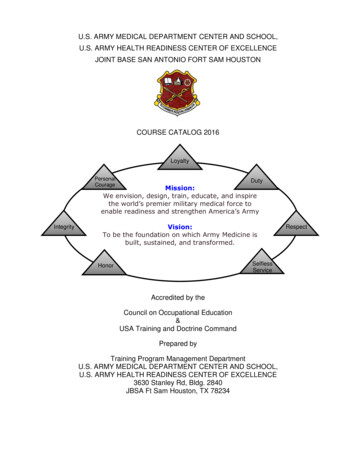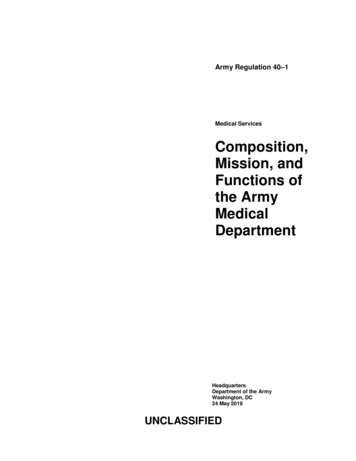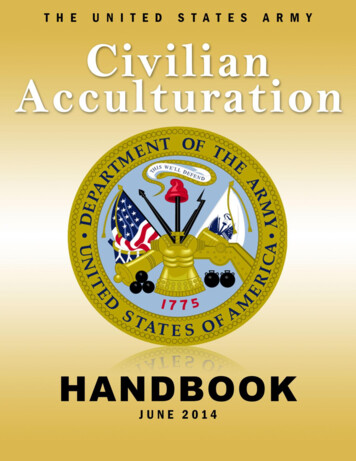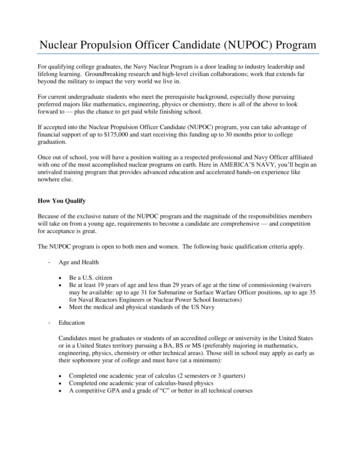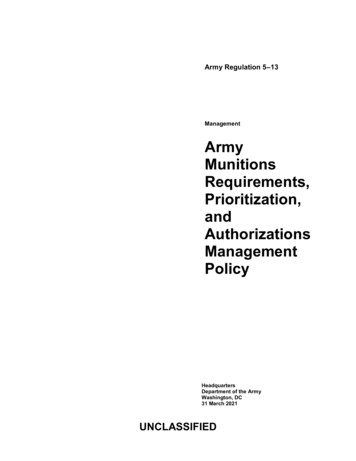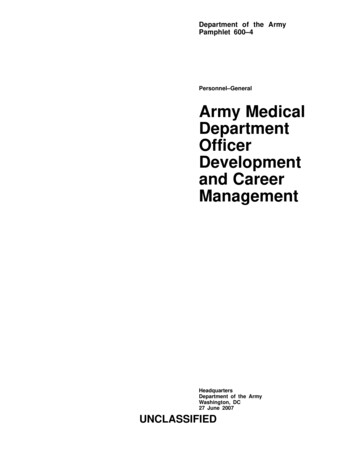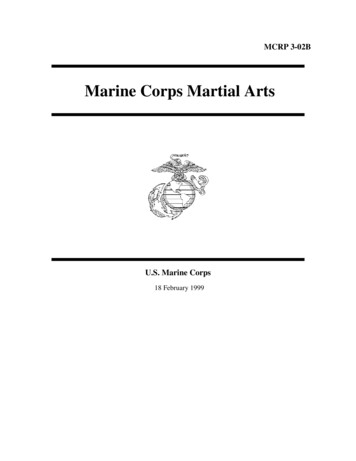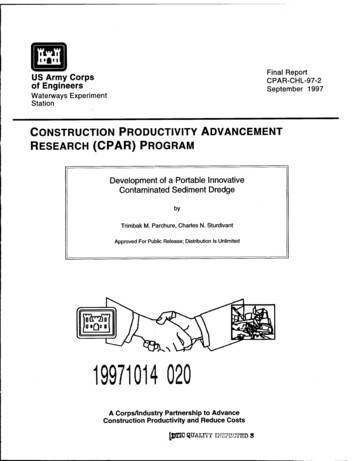
Transcription
Final ReportCPAR-CHL-97-2September 1997US Army Corpsof EngineersWaterways ExperimentStationCONSTRUCTION PRODUCTIVITY ADVANCEMENTRESEARCH (CPAR) PROGRAMDevelopment of a Portable InnovativeContaminated Sediment DredgebyTrimbak M. Parchure, Charles N. SturdivantApproved For Public Release; Distribution Is Unlimited19971014 020A Corps/Industry Partnership to AdvanceConstruction Productivity and Reduce Costs[PEC QUALITY DFSPECTED 3
The contents of this report are not to be used for advertising,publication, or promotional purposes. Citation of trade namesdoes not constitute an official endorsement or approval of the useof such commercial products.The findings of this report are not to be construed as anofficial Department of the Army position, unless so designated by other authorized documents. PRINTED ON RECYCLED PAPER
Technical ReportCPAR-CHL-97-2September 1997Construction Productivity AdvancementResearch (CPAR) ProgramDevelopment of a Portable InnovativeContaminated Sediment Dredgeby Trimbak M. ParchureU.S. Army Corps of EngineersWaterways Experiment Station3909 Halls Ferry RoadVicksburg,MS 39180-6199Charles N. SturdivantDRE Technologies137 Alpha DriveFranklin, TN 37064Final reportApproved for public release; distribution is unlimitedPrepared forU.S. Army Corps of EngineersWashington, DC 20314-1000lUTIC QUALITY XIT»-5TEDS
US Army Corpsof EngineersWaterways NTALMBORATORYFOR INFORMATION CONTACT:PUBLIC AFFAIRS OFFICEU.S. ARMY ENGINEERVWJERWAYS EXPERIMENT STATION3909 HALLS FERRY ROADyjCKSSURG, MISSISSIPPI 3918W5199PHONE (601) 634-2502«SEA OF RE9EAVAT»» ,2.7331»!Waterways Experiment Station Catalogingnn-Publication DataParchure, T. M. (Trimbak Mukund), 1943-8" «.Sturdivant, Cha.es N. „.UnitedIV. Coastal and HydraulSTSStov wf AZI !neer Waterways Experiment Station.V. Construction l facöXTdSS Ä ?18* Wf5 Experiment Station)VLTechnical report (U.S. Arm?Enqlr e- VII. SeriesWaterwa sTA7 W34 no CPAR-CHL 7-2y Expenment Station); CPAR-CHL-97-2.
ContentsPrefaceVIAcknowledgments1—Project BackgroundIntroductionDRE Technologies IncCollaborative Research ProgramResearch and Development InvestmentApproachTheDryDREdge Impact On U. S. IndustryImpact On Corps of Engineers2—Design and Fabrication .DesignFabricationPreliminary Testing3—Laboratory Tests at WES. fc.TIntroductionProcurementsPlanning and DesignResearch Facility ConstructionSediment CharacterizationPump and Pipeline Tests4—Field Tests at WESIntroductionField TestingProblems and Trouble ShootingModifications to Dry DREdge 5—Field Tests at Louisville, KYPerformance of Modified Dredge2.*g899101010.„J24. 6 2837J37HI
6—Marketing and Technology TransferMarketingTechnology TransferAdditional Information3g'" 'f*,g7—Conclusions .40References .42BibliographyAppendix A: CPAR Executive Summary, FY 95A1Appendix B: DRE Brochure on Dry DREdge B1Appendix C: Fact Sheet Dated 3 January 1996C1Appendix D: Fact Sheet Dated 1 August 1996D1Appendix E: Fact Sheet Dated 1 January 1997SF298E1List of FiguresFigure 1.Schematic drawing of DRY DREdge Figure 2.Figure 3.View of pipelines inside the test facility at WESRecirculating pipes13Figure 4.Kaolinite and bentonite in bags14Figure 5.Flash mixer used for initial mixing of sediment and water15Figure 6.View of concrete mixer used for mixing sediment and water . 16Figure 7.View of scissors-lift-type elevating platformj7Figure 8.View of reciprocating two-cylinder pump used forpumping mud,0loView of hopper attached to pump for temporarystorage of sediment,oFigure 10.Mixture of sediment and water poured in pump hopper19Figure 11.Mixture of sediment and water returning to the hopper afterflow through pipe20Figure 12.Pressure gauges installed at the bend on pipeline20Figure 13.Pressure gauges installed halfway on the two pipesFigure 14.Size distribution of sand used for laboratory sediment mixtures . 22Figure 15.Dry DREdge in the fabrication shopFigure 9.IV5u2124
Figure 16.Dry DREdge mounted on trailer25Figure 17.Crane used for lifting Dry DREdge 26Figure 18.Dry DREdge being lifted by crane27Figure 19.Transportation of Dry DREdge towards lakeFigure 20.Dry DREdge being dragged towards lake29Figure 21.Channel being dredged for launching30Figure 22.Dredge launched into the channel leading to lake31Figure 23.Right spud in position, left spud being lifted31Figure 24.Right and left spuds in position, rear spud beingplaced into position32Figure 25.Dredge working in the lake32Figure 26.View of horizontal dredge armFigure 27.Bucket filled with sedimentFigure 28.Figure29.Bucket emptying into hopperBooster pump halfway on the pipelineFigure 30.Discharge of sediment at the disposal ground3Figure 31.Figure32.View of sediment disposal siteView of disposal site after quick drying35283334 36
PrefaceSection 7 of the Water Resources Development Act of 1988, P. L. 100-676,33, U.S.C. 2313, and the Stevenson-Wydler Technology Innovation Act of 1980as amended, 15 U.S.C. 37102a, provide the legislative authority for theConstruction Productivity Advancement Research (CPAR) Program The CPARProgram allows the U.S. Army Corps of Engineers (USACE) to enter intocooperative research and development agreements with construction industrypartners to conduct cost-shared, collaborative efforts with the goal of improvingconstruction productivity.Memorandum CEWES-OC-Z was issued on 23 February 1995 enclosingcopies of the Cooperative Research and Development Agreement (CRDA)document which was jointly signed by U.S. Army Engineer WaterwaysExperiment Station (WES) and DRE Technologies Inc. This memorandumconveyed approval of the Director of Civil Works for WES to enter into CPARCRDA wth DRE Technologies Inc. for "Development of a Portable InnovativeContaminated Sediment Dredge."The research work was conducted by personnel of DRE Technologies Incand the WES Coastal and Hydraulics Laboratory (CHL), Vicksburg, MS, during1995 -1996. Funding for this project ( 675,000) was received from theGovernment under the CPAR Program and an amount of 855 000 wascontributed by DRE Technologies Inc.Dr. Trimbak M. Parchure, Waterways and Estuaries Division, CHL, was thePrincipal Investigator for the project and Mr. Charles Sturdivant of DRETechnologies Inc. was the Principal Investigator of the partner. Dr. Parchureprepared this report jointly with Mr. Sturdivant. Dr. Parchure conducted theproject work under the general supervision of Messrs Allen M. Teeter LeaderSedimentation Engineering and Dredging Group; William H. McAnally JrChief, Waterways and Estuaries Division; Richard A. Sager, Assistant DirectorCHL; and Dr. James R. Houston, Director, CHL. William F. McCleese of WESmonitored the progress of the project, provided advice, and maintained constantliaison with Headquarters, USACE. The USACE Technical Monitor wasMr. Tom VemaVI
This report is being published by the WES Coastal and Hydraulics Laboratory(CHL). The CHL was formed in October 1996 with the merger of the WESCoastal Engineering Research Center and Hydraulics Laboratory. Dr. JamesHouston is the Director of the CHL, and Messrs Richard A. Sager and CharlesCalhoun, Jr. are Assistant Directors.During the preparation and publication of this report, Dr. Robert W. Whalinwas the Director of WES.The contents of this report are not to be used for advertising, publication, orpromotional purposes. Citation of trade names does not constitute anofficial endorsement or approval of the useofsuch commercial products.VII
AcknowledgmentsThe joint CPAR project between DRE and the U. S. Army Corps ofEngineers on the Development of a Portable Innovative Contaminated SedimentDredge officially started in February 1995 after both parties signed the CPARCRDA. The groundwork, however, had started in 1994. The project continuedfor a period of two years and was completed in December 1996.Successful completion of this project was possible only because of theexcellent cooperation and participation of personnel from both sides. Inparticular, appreciation is expressed to the following individuals and companies:a.DRE contractors Automated Equipment Inc., located in Paris, TN,completed the initial fabrication of the dredge on time for undertakingthe lake dredging project at WES. They also made several modificationsto the dredge after the first field trial.b.Mr. Glynn Banks was the key person at WES during the entire field trialof lake dredging. He offered advice on availability of labor, materials,repair facilities, and renting services from the local market in Vicksburgand Jackson, MS. He provided several valuable suggestions for makingmodifications to enhance efficiency of the dredge during actualoperation.c.The initial dredge design was done by Mr. Charles Sturdivant of DRE.He was involved with the project from the very beginning and was alsoresponsible for monitoring dredge performance and for makingsubsequent modifications.d.Ms. Rachelle Green prepared and published an article on the field trial ofDryDREdge .e.Participation and assistance from the following DRE personnel isappreciated:(1) Mr. James Harlan for conducting the pump tests.(2) Mr. Samuel Escue for numerous engineering support activities.VIII
(3) Mr. Kerth Northrop for supervising the field testing at WES.(4) Mr. Mark Frazier for supervising the field testing at Louisville, KY.IX
1Project BackgroundIntroductionA survey of portable hydraulic dredges was undertaken at the U. S. ArmyEngineer Waterways Experiment Station (WES) in the years 1981-1982. Areport entitled "Survey of Portable Hydraulic Dredges" was published by Clark(1983) on the findings of the survey, which was limited only to the U.S. market.This report summarized a wide variety of portable dredges available in theUnited States. It was revealed that the dredging depths ranged from 3.048 to18.3 m (10 to 60 ft) and production rates ranged from 15.3 to over 1,376.2 cu m(20 to over 1,800 cu yd) per hour. The cutting mechanisms included ordinarycutterheads, ladders with chain cutters, bucket wheels, horizontal cutters, twinrotating vertical cutters, open suction dustpans, and jet pumps. The degree ofportability varied considerably. Individual descriptions and a summary chart foreach dredger are given in Clark (1983).Ten years after the above report, another survey on portable dredgers wasconducted by WES (during 1993) and a report entitled "Equipment forContaminated Sediment Dredging" published by Parchure (1996). This surveywas restricted to only the equipment available in the U.S. market suitable forcontaminated sediment dredging. In all, 64 companies related to dredgemanufacture were contacted. Out of these, information on their respectiveproducts was received from 24 companies. A careful scrutiny of the informationrevealed that only 7 companies offered equipment which appeared promismg forcontaminated sediment dredging.Considerable emphasis has been being placed in recent years on the toxiccontents of sediment to be removed from our waterways. Special attention andtechnology are mandated by regulations if the sediments to be removed arecontaminated. According to an estimate given in the Office of TechnologyAssessment document 0-334, entitled "Wastes in marine environment," (Clark1987) approximately 3 percent of the material dredged from the estuaries andcoastal areas each year in the United States is heavily contaminated. The cost ofremoving, transporting, and disposing this material is three to six times as muchas noncontaminated material.ChapterlProject Background
Three major problems are associated with dredging contaminated sediments.First, contaminated sediments are mostly fine (consisting of silt and clays) andmay be highly compacted. Specialized devices are needed for cutting andloosening them before transporting. The second problem is the ease with whichdredged fine sediments are vertically resuspended and dispersed within the entirewater column. A few grams of fine sediment may contain millions of particles inthe micron-size range, and they attenuate penetration of natural light in the watercolumn, thus adversely affecting the aquatic plants and water quality. The thirdproblem is the extremely low rate of deposition of fine sediments and the ease atwhich they may be transported over great distances from the point of origin evenunder a very weak current.Innovative equipment developed through a cooperative research project isdescribed in this report. This equipment is expected to allow the Corps ofEngineers and others to remove contaminated material from our nation'swaterways and from water bodies located on military reservations with minimalimpact on the environment. The dredging and disposal costs are expected to be40 to 70 percent lower than that with the use of presently employed conventionaldredgers. The main advantage of the new system is the reduced overall volumeof sediments and water to be handled and treated. In addition, precise dredgingwill be useful in closely following the predetermined limits of contaminatedsediments and also in avoiding unexploded ordnance at certain sites. Theequipment is portable and small in size. Hence, it can be easily transported anddeployed at small projects such as dredging of marinas and industrial lagoonswhere access near piles and other structures inside basins is severely restricted.DRE Technologies Inc.DRE Technologies Inc., located near Nashville, TN, has been providingspecialized pollution control services since 1987. Specific services haveincluded engineering, construction, start-up, permitting, and operation offacilities mvolved in the destruction and/or treatment of hazardous waste andwastewater, surface and subsurface investigations, remedial action, and wasteminimization. The various types of services offered by the company includedesign services, operational services, remediation services, and regulatoryassistance services.DRE's interest in dredging technology began in the early 1990s. Thecompany was seeking an economical and environmentally acceptable method toexcavate, dewater, and feed contaminants to treatment systems at remedial actionsites. The conventional methods of hydraulic and mechanical dredging hadsevere limitations for this type of work. The company was interested inundertaking a project for developing new technology that would be most suitablefor the job and requested assistance from WES to provide research supportChapter 1Project Background
Collaborative Research ProgramSuccessful negotiations were held between WES and DRE Technologies Inc.in 1994 on the possibility of working together for the development of a portableinnovative dredge for removal of contaminated sediments. Funding for the jointproject was provided by the Government's share of the Construction ProductivityAdvancement Research (CPAR) Program.The project objective was to develop and demonstrate a new concept fordredging contaminated sediments. The product will be a commercially availableportable dredge capable of accurately removing and transferring subaqueousmaterial near in situ densities while minimizing resuspension of contaminatedsolids.The document "Research, Development and Commercialization Plan"(RDCP) was prepared which contained project description, tasks to be performedby both parties, and a schedule in the form of milestones. The document wassigned by DRE and WES in February 1995. Appendix A gives the CPARExecutive Summary.Research and Development InvestmentThe total research and development (R&D) cost of the project was 1,550,000, with each partner contributing funds over a 2-year period asindicated below. On this CPAR project, no funds were provided to DRE directlyby the Government. Contribution of DRE was 200,000 more than theGovernment contribution.PartnerYearlYear 2TotalDRE 750,000 125,000 875,000Corps 330,000 345,000 675,000Total 1,080,000 470,000 1,550,000ApproachThe development of the dredge included design, fabrication, and testing. Thedesign was produced by DRE; fabrication was done by a sub-contractor; andWES helped in conducting laboratory and field testing. The following approachwas envisaged for development:Phase 1:The validity of the fundamental premise upon which this project wasbased will be established in this phase - namely that a high pressurepositive displacement pump is capable of pumping dredged sedimentChapter 1 Project Background
at near in situ moisture content. This concept had not beendemonstrated either by the dredging industry or by the pumpindustry.Phase 2:Detailed design and construction of the dredge will be accomplishedin this phase. The design will include a sealed clamshell mountedon a rigid telescopic boom. This configuration will permit accuratecontrol on location and in situ hydraulic closure as well as filling ofclamshell, thus reducing resuspension of bed sediment normallyassociated with the impact of a free-falling, cable-suspendedclamshell.Phase 3:Testing of the prototype dredge at two field dredging sites will bedone during this phase. During the tests, changes in the suspendedsediment concentration of ambient water will be measured, and datarelated to production rate and performance of the dredge will becollected and analyzed. A videotape will be made for technical andcommercial distribution.The purpose of the proposed research was to provide the constructionindustry with improved capability for removing contaminated sediments and toreduce the volume of material to be transported and disposed. Material removedwith the proposed equipment will have close to in situ water content which maybe on the order of 20 percent as opposed to the current hydraulic dredgingpractices which add about 200 to 400 percent volume as water.The Dry DREdge The new dredge developed under the CPAR Project has been designed as ageneral purpose, easy-to-use tool and is now readily available in the market. Thedredge is intended for use in environmental, industrial, and municipal projects.The new concept may be considered to be hybrid since the design offersadvantages of both the mechanical and hydraulic dredge. The objective of thedesign was to provide a commercially available portable dredge capable ofaccurately removing and transferring subaqueous material at near in situ densitieswhile minimizing resuspension of contaminated solids. The new dredger isnamed Dry DREdge in view of the low water content of the dredged sedimentIt has received U. S. Patent No. 5,311,682.A schematic drawing of the Dry DREdge is given in Figure 1. The dredgehas a specially designed sealed clamshell mounted on a rigid, extensible boom.The open clamshell is hydraulically driven into the sediments at a low speed,minimizing sediment disturbance and resuspension. The clamshell is thenhydraulically closed and sealed, trapping a plug of sediment at its in situ watercontent. The sediment is deposited in the hopper of a positive displacementpump which delivers it through a pipeline to the disposal site. Depending on thesite conditions, the hopper can be equipped for debris screening, size reduction,Chapter 1Project Background
DRAWIROPERTHEED OF,JIPMENG AND THE 1 NFORMATICY OF DRE EN VIRONMENl PRESS AGREEMENT THDIRECTLY OR INDIRECTLOR APPARA TUSWITHOFIRS T OBTAINEIT CONTAINS,SERVICES, BIT WILL NOTAND WILL NOWRITTEN PEPAND SPECIFICDESIGN, ISS SUBMITTEOTHERWISEMANUFACTUTAL SERVICIE ZDOOOOO2Chapter 1 Project Background1ZI UDING THE P RINCIPAWOOD TENNESSEE, AEPRODUCED, COPIED,USED AS A BASIS FON OF DRE ENVIRONTO EACH CA BE. LUtoJ S gZOOSILCD L5CM«»za.lo O- Q-ftoO Z3 1—Z 1—i.i EzUJ" , SUJ gl—g 00CMC5oooCMoto u.UJET o9T CMCO1zUJ0UJ3aUJ GOcc KJ Q§K5w 3— o: co i— 3mU) inZ 2S 5- 5 O. — —iO)TJUJcca -LtQc OO) DO(0 .«JZEa oCOil
vapor emission control, sediment homogenization, and blending of additives tomodify flow properties. The sediment pumped in a plastic flow regime may havethe consistency of a toothpaste. Depending on the in situ moisture content andthe degree of hazard posed by the sediment, the disposition may be directed to athermal treatment or stabilization process, to an onsite land disposal, or to anenclosed transport vehicle.The dredge is portable and therefore capable of being transported by roadwithout major disassembly. Only one truck is required to transport DryDREdge , and the setup requires a crane and approximately 16 man hours.Larger units suitable for operation in coastal environments require three or fourtrucks and approximately 80 man hours of setup labor.Extensive special training is not needed to operate Dry DREdge since it canbe operated by an experienced dredgeftackhoe/clamshell or dragline operatorHowever, a deckhand is required to assist the operator in handling the pipe andto perform normal maintenance duties. The new dredge is expected to have aservice life in excess of 15 years if regular maintenance is performed. No majormodifications are necessary to meet customer-specific requirements.The design employs technologies well-proven in other industries. Theprimary task in the development of this dredge was the integration of thesetechnologies into a reliable piece of equipment.Impact On U. S. IndustryThe new dredge should satisfy a need in the dredging industry: a machinecapable of excavating and transporting sediments without the addition of largeamounts of water. This feature will allow dredging of areas that cannot presentlybe dredged due to the nonavailability of a large and suitable containment area forpumping slurry for gravitational settling. Small jobs, such as dredging ofmarinas and private boat docks, will no longer require the construction of largesedimentation basins and return water systems. Due to the reduced amounts ofwater, the dredge discharge can be directed into much smaller geographicdepressions or cells constructed for that purpose.The environmental remediation business will be favorably affected by theintroduction of the new dredge. With the Dry DREdge , sediment dredgingprojects can be performed without the expense of dewatering and treating largeamounts of water. Also, direct pumping to prepared disposal and draining areascan be considered instead of using expensive treatment systems.For those projects where the material to be removed is first transformed intoslurry for ease of pumping and the slurry is then mechanically dewatered(primarily environmental projects), the new design will offer an option whichwill greatly reduce the cost of dewatering and water treatment.Chapter 1 Project Background
Additionally, the new design overcomes a common problem plaguing smalldredges used to feed dewatering equipment, namely, frequent shutdown frompipe blockage due to debris. The hybrid dredge operation is largely unimpededby debris since the sediment is screened and readily visible to the operator formanual removal of debris, if needed, before it enters the pump.Impact On Corps of EngineersThe impact on the U.S. Army Corps of Engineers will be the following:a. The dredge will be capable of precise, low impact excavation. Thisfeature is useful when the cut lines are precisely defined, as in manyComprehensive Environmental Responsibility Compensation andLiability Act (CERCLA) (Superfund) projects, which must be adhered tobecause there may be a risk of encountering unexploded ordnance (UXO)beyond these lines.b. The dredge will be very useful for small dredging projects of the Corps ofEngineers, particularly those which involve excavation and treatment ofcontaminated sediments.c. With the new dredge, the dewatering and water treatment costs will besubstantially reduced as will the exposure of personnel to thecontaminants.d. The portable dredge will be useful for inland dredging sites such as lakesand ponds.e. The dredge will be useful for the dredging of commercial marinas andprivate boat docks./Chapter 1The new dredge will eliminate or greatly reduce the return water from thedisposal cell used for a conventional hydraulic dredge. This will, in turn,eliminate or reduce the adverse environmental impact from the returnwater.Project Background
2Design and FabricationDesignThe new dredge design was required to overcome the disadvantages ofconventional dredges deployed for removal of contaminated sediments. Thesedisadvantages are as follows:a. Resuspension of sediment at the point of excavation is often significant,and it may adversely affect the quality of water.b. Excavation of "hot spots" may not be precise.c. A large quantity of water is required to be mixed with the sediment inorder to make it flow properly through a pipe when a centrifugal pump isused.d. High water content of the dredged sediment requires large, expensiveconfined areas for disposal and settlement of sediment.e.When the sediments are contaminated, return water from confined areasis also polluted, and its discharge back into the same body of water maynot be permitted./High water content of polluted sediment dramatically increases the cost ofincineration since substantial energy is wasted in evaporating largequantities of water.The main component of the new dredge is the positive displacement pump.DRE contacted and negotiated with five pump manufacturers. DRE alsosurveyed all known pipe-coupling manufacturers and compiled information onall options for steel and plastic pipes available in the market. The hull of thedredge was not to be designed to make it a sea-worthy dredger. The new dredgewas designed only for inland and protected areas where wave action is not amatter of concern. A joint meeting of WES and DRE officials was held at WESon 24 March 1995 to discuss details of the project. Research facilities existing atWES were inspected to determine their suitability for pump testing.8Chapter 2 Design and Fabrication
The design of the clamshell offers several noteworthy features. The clamshellcan be extended from the surface of the water through layers of water orsediment to the desired depth of sediment to be removed. The clamshell(0.1982 cu m (7 cu ft) volumetric capacity) can then be closed, sealing sedimentinside the clam. This prevents the sediment from leaking out or being diluted byinfiltrating water or other sediment layers while the clam is raised to the watersurface.The system for positioning the clamshell on the sediment bed and providingfeedback to the dredge operator consists of electronic sensors, a computer, and adigital display inside the operator's cabin. This display indicates the extension ofthe boom, the clam position or offset to either side of the dredge center line, andthe depth'of the clam below the water surface. This system allows the operatorto consistently dredge at a predetermined depth and not leave undredged areas.For small projects such as the dredging of marinas and industrial inlandlagoons, elaborate on-line data acquisition systems are not necessary. Nucleardensity meters are available for determining the density of sediment flowingthrough a pipe. A comprehensive global positioning system (GPS) is available inthe market for accurate positioning of a dredger in open water sites. Alsoavailable in the market is elaborate and expensive software, such as HYPAC ,that provides on-line data on depth of dredging and computation of volume ofdredged material among many other features which require an on-boardcomputer. If needed, such accessory facilities can be installed for operation in alarge area.DRE first prepared the manpower allocation schedule for the design phaseand employed qualified personnel for the job. Clamshell design and spud systemdesign were completed by September 1995, and the entire design job wascompleted by November 1995, thus meeting Milestone 2 one month ahead ofschedule.FabricationThe contract for fabrication of the dredge was given to Automated EquipmentInc., Paris, TN. The work was completed by mid-April 1996, two months aheadof schedule.Preliminary TestingPreliminary testing of the engine, pump, and other parts was done at the shopat Automated Equipment Inc. The dredge was then taken to a nearby pond totest its dredging ability. Both these preliminary tests were completedsatisfactorily, thus making the dredge ready for a field test.Chapter 2 Design and Fabrication
3Laboratory Tests at WESIntroductionResearch work under the CPAR Program was conducted at WES. It was usedto ascertain the validity of the fundamental premise upon which this project isbased, namely, that a high-pressure positive displacement pump is capable ofpumping dredged sediments at near in situ moisture contents. Additionally, thisresearch was used to measure and compare the hydraulic characteristics of steeland polyethylene pipe in service with various types of sediment. These datawere crucial to the successful design of the dredge. From the initial inquiries,DRE ascertained that none of the pump manufacturers had conducted tests ondifferent types of pipe, nor had they collected necessary data Detailed designand construction of the dredge was finalized only after the results of the pumpand pipeline testing program were analyzed and the viability of the concept wasaffirmed.ProcurementsA concrete mixer, a piston-type concrete pump, a scissors-lift-type elevatingplatform, a flash mixer, and an air compressor were rented by DRE for operationat WES. Three types of sediments (kaolinite, bentonite, and sand) and a storagetank were purchased by WES. Steel pipes, plastic pipes, flexible hoses, lumber,valves, couplings, and pressure meters were purchased by DRE.Planning and DesignDRE performed pressure, flow, and velocity calculations in support of thepipe selected for testing. Based on the information related to equipment andmaterials available in the market, a testing plan was developed. In consultationswith WES, a layout drawing showing a 12.7-cm- (5-in.-) by 274.32-m- (900-ft-)long steel pipeline, couplings, pressure gauges, pump, and other technical detailswas prepared for use in construction of the testing facility.10Chapter 3 Laboratory Tests
Appendix B: DRE Brochure on Dry DREdge B1 Appendix C: Fact Sheet Dated 3 January 1996 C1 Appendix D: Fact Sheet Dated 1 August 1996 D1 Appendix E: Fact Sheet Dated 1 January 1997 E1 SF298 List of Figures Figure 1. Schematic drawing of DRY DREdge 5 Figure 2. View of pipelines inside the test facility at WES u Figure 3. Recirculating pipes 13
